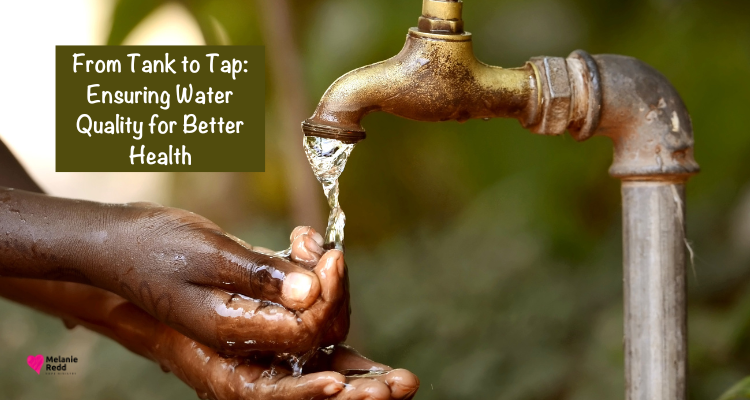From Tank to Tap: Ensuring Water Quality for Better Health

From Tank to Tap: Ensuring Water Quality for Better Health
Water, being the essential matrix of life, has paramount importance in maintaining the health and survival of every living creature.
The interplay of water tanks and human health is compelling as these reservoirs serve to not only provide a continuous supply but also as critical junctions for suppressing waterborne infections spreading into our homes. This discourse aims to explore how we can ensure better health by managing and maintaining the quality of water from tank to tap.
Understanding Water Quality
The foundation stone of our argument – water quality – is an intricate term shaped by its physical attributes, chemical constitution, and biological associations.
These collective factors tacitly define whether the water we are consuming is fit or unfit for human use. The ideal characteristics of high-quality water pivot around balanced mineral content, a significantly low manifestation of hazardous substances along with the total absence of disease-causing entities.
From Tank to Tap: Ensuring Water Quality for Better Health – Roles of Water Tanks
Rooted deep within our water supply system, water tanks serve dual functions: providing storage for immediate use and ensuring stability of water supply during periods of scarcity or demand fluctuations.
Furthermore, these enormous containers can act as impregnable fortresses against impurities if coupled with fine-grade filters and potent disinfectants, thereby making them an important constituent in ensuring clean water from source to consumer.
Types of Water Tanks
To effectively deal with issues relating to our water quality, we need an intimate understanding of the infrastructure that holds up our system like a backbone – namely the different types of water tanks used throughout this chain process from source to tap. Underground tanks preserve cool temperatures aiding in the suppression of microbial growth but simultaneously face the potential threat from contaminants present within surface runoff seeping below surface level.
On the other hand, aboveground tanks or elevated ones function differently when it comes to cordoning off unwanted elements. For a comprehensive understanding of the types, materials, sizes, and best uses for various tanks, resources like TheWaterTankFactory.com.au offer valuable insights.
Health Risks Associated with Poorly Managed Tanks
Reservoirs and tanks, if handled incompetently, can swiftly transform from health-promoting assets into hazardous ticking bombs cluttered with contaminants and infectious organisms. Stagnant water could host colonies of hazard-laden bacteria or fungi; even toxicity-producing algae could find a hospitable environment in neglected tanks. Equally worrisome is the heavy drums of hazardous metals that gradually accumulate over time due to aging pipe systems causing long-term health impacts like neurological disorders.
Standard Regulations for Water Tank Maintenance
Given this dreadful palette of harm that neglected water tanks hold, adhering to standard regulations regarding maintenance is critical and non-negotiable for tank owners and caretakers whether employed by governmental organizations or individual households. These regulations cover a broad array which includes mandatory cleaning schedules, disinfection measures or even coloring codes indicating safety levels – all playing an important role in preserving public health and preventing waterborne diseases.
Common Mistakes in Maintaining Water Tanks
Despite all the guidelines and strict regulations, there are often pitfalls and mistakes that individuals or organizations fall into while managing water tanks. These blunders range from ignoring routine cleanings to negligent disinfection procedures. Some common misconceptions include the belief that having a sealed tank means one doesn’t need to regularly check and clean it, or that using excess chemicals can ‘make up’ for extended periods between cleanings. Both these examples showcase the urgent need for re-education about proper tank maintenance.
The result of Poorly Maintained Water Tanks on Public Health
Concrete examples indeed speak louder than abstract concepts. To drive home the importance of quality-maintained tanks, we look into numerous instances from around the world where neglecting water maintenance led to serious public health crises. In urban locales, lack of tank regulation may lead to mass poisonings while in rural areas people often find themselves facing persistent health issues due to the absence of any form of water treatment facilities.
Methods to Ensure Clean Water from Tank to Tap
Having seen what can go wrong without proper water management, we must explore how to ensure clean water transitions safely from tank to tap. This is not just about cleanliness protocols for tanks but also about the inclusion of technology in the treatment process such as filters and disinfectants alongside regular physicochemical analyses. Participation from users in monitoring quality and reporting discrepancies can also act as an extended eye toward greater efficiency.
Importance of Regular Checks and Inspections
Exactly like a regular health check-up, scheduled reviews and inspections of your water storage systems have immense benefits such as early detection of potential threats to structural integrity as well as potential contaminants before they turn into major problems. Such routine checks also confirm our adherence to mandatory compliance with standard regulations – doing so reassures us about whether our efforts towards maintaining healthy water quality are on the right track.
Role of Authorities and Individuals
The burden of maintaining our health through water quality doesn’t lie solely on technology or regulations; there’s an intrinsic role to be played by individuals and authorities too. Enhanced public awareness campaigns, strict and unfailing enforcement of regulations, as well as setting up avenues for knowledge dissemination by authorities work in consonance with an individual’s commitment to his/her family’s health needed to maintain and uphold water quality standards.
Conclusion – From Tank to Tap: Ensuring Water Quality for Better Health
In a system such as water maintenance where complexities abound, ensuring quality from tank to tap is a task that demands great care alongside constant supervision. Returning to the motif of this discussion – better management equals better health – we observe that practices such as regular checks, abiding by regulations, and choosing appropriate disinfection tactics while avoiding common missteps can indeed pave the way toward improved public health via appreciably high-quality water served right at our taps.
Were you encouraged by what you read?
Then, would you share this article with a friend, co-worker, or family member?
Or, maybe you can send it to a friend or family member?
This blog occasionally uses affiliate links and may contain affiliate links.
Additionally, Melanie Redd is a participant in the Amazon Services LLC Associates Program.
This is an affiliate advertising program designed to provide a means for sites to earn advertising fees. These are earned by advertising and linking to amazon.com.
Also, for more on my disclosure policy, click HERE.
© Melanie Redd and Hope Ministry, 2024. Unauthorized use and/or duplication of this material without express and written permission from this blog’s author and/or owner is strictly prohibited.
Further, excerpts and links may be used, provided that full and clear credit is given to Melanie Redd and Hope Ministry.
Please give appropriate and specific directions to the original content.



0 Comments